Commitment to Diversity & Inclusion Report (2019-20)
A Message From Our CEO
The year 2020 was a redefining moment in history. The impact of the COVID-19 pandemic was far-reaching and will no doubt be felt for years. It sparked a series of events that brought a national focus on systemic racism and social injustice. A struggling economy accentuated inequities and America was forced to confront racism. Never have practices that bring people together around common goals been more important.
As the nation’s largest public pension fund, we knew we had the opportunity to lead and that our organizational diversity and inclusion practices would help find solutions. We acted, establishing a Chief Diversity & Inclusion Officer position among our Executive team. We also began to develop a framework that outlines the goals, objectives, and initiatives toward achieving a diverse, equitable, and inclusive working environment built on consistent data. The framework addresses five key areas: culture, talent management, health care equity, supplier diversity, and our investment program. It establishes a strong business case for diversity as fiduciaries of the system and helps to align management and business practices and policies accordingly.
CalPERS has embraced diversity and inclusion practices for nearly two decades. It has helped shape the culture that contributed to our adaptability in the COVID-19 environment and continually enables us to be customer-focused, operate efficiently and effectively, drive team engagement, be a reliable partner, and a best practice leader.
As we look ahead, we do so with a renewed focus on diversity, equity, and inclusion practices that our members and our nation need now. CalPERS is steadfastly committed to lasting change.
Sincerely,
Marcie Frost
Chief Executive Officer
Business Initiatives Guide Our Work
All our diversity and inclusion work is guided by our strategic business initiatives, which represent one aspect of our overall strategic plan for the enterprise. Listed below are fiscal-year accomplishments articulated throughout the report. Of special note are the five-year highlights given that 2020 is the end of the five-year business initiative cycle.
2019-20 Fiscal Year Accomplishments
- Expand Diversity & Inclusion (D&I) Program: Sustain the strategy to embed diversity and inclusion as an enterprise comprehensive approach to be a leader in best practices and to meet organizational goals
- Associated Strategic Measure: Employee Engagement survey results and action items for diversity and inclusion
- Established Diversity & Inclusion Council to guide enterprise-wide diversity and inclusion efforts
- Expanded education and training to all team members
- Developed new employee survey to capture self-identifying demographic data
Five-Year Accomplishments
- Established a common diversity and inclusion language including key terms, vision, and mission
- Developed and implemented a comprehensive enterprise D&I Strategy to meet organizational goals and position CalPERS as a best practice leader
- Achieved year-over-year improvement for the D&I Strategic Measure since the initiation of the Expand D&I Business Initiative in 2016
Overview
The 2019-20 Commitment to Diversity & Inclusion Report frames our fiscal-year accomplishments around three focus areas: Talent Management, Education, and Communication. It also highlights the work of our Investment Office to engage companies that we invest in about the importance of diversity and inclusion for long-term value creation. Additional engagement activity included in the report addresses our vendor contracting practices as well as the work of our health program around health care equity. Finally, the report examines the detailed diversity and inclusion activities across the organization led by the CalPERS Diversity Outreach Program to aid employees through employee resource groups, accessibility efforts, and ongoing communication and outreach efforts.
Talent Management
Diversity and inclusion play a central role in CalPERS’ ability to recruit and retain top talent and empower team members to deliver quality customer service to our members. With the COVID-19 pandemic came a heightened importance of diversity and inclusion practices to find creative solutions of every kind to support team members’ changing needs.
2019-20 Fiscal Year Accomplishments
- Held daily COVID-19 executive huddles that identified real-time issues impacting our workforce, coupled with daily communication to consistently share factual information, and resources to help team members with work-life balance issues such as The Families First Coronavirus Response Act leaves, Emergency Paid Sick Leave, and Emergency Family Medical Leave Act
- Implemented a new employee survey tool for self-identifying information including:
- Eight new ethnicity categories
- Sexual Orientation and Gender Identity (SOGI)
- Conducted ongoing pulse surveys to gather data on emerging topics, such as COVID-19
- Transitioned in-person Career Services consultations successfully to virtual consultations to continue aiding team members looking for support to advance their career
- Launched CalPERS Upward Mobility Program, designed to help team members in their goals of promoting within the organization
- Recruited 37 new hires with outreach through LinkedIn
- Hired 18 student assistants in collaboration with University Enterprises, Inc., CSU, Sacramento, and UC Berkeley
- Developed CalPERS' Investment Associate Student Program
To understand how team members perceived CalPERS’ response to the pandemic, our Human Resources Services Division developed and distributed a survey to gather feedback on how individuals’ work was impacted. The data provided timely, relevant information to help inform decisions and action plans on a variety of topics such as resources and support, employee empowerment, manager relationships, and growth and development. Here’s what we learned:
- Overall, team members’ perceptions of CalPERS’ response to the COVID-19 pandemic was very positive. Significant findings include:
- Agreement that CalPERS was supportive of our customers
- A clear understanding of efforts taken to protect the health and safety of employees and the public
- Satisfaction with the ongoing communication to keep abreast of pandemic-related developments
Going forward, we will continue to use pulse surveys to listen to team members’ needs and to measure the moments that matter—times that can have a major impact on how people perceive and respond to changing circumstances. The more real-time data we can collect, the more our decisions can positively impact team member engagement, productivity, performance, and retention.
Virtual services included:
- Conducted 171 virtual Career Services consultations for team members interested in career advancement
- Provided Career Services presentations to three divisions
- Hosted the first virtual CalPERS Career Development Day, featuring live senior leadership webchats and an Inside CalPERS intranet ‘takeover’
- Facilitated Virtual Mentoring Week featuring one-on-one mentoring and speed mentoring activities
- Participated in five external virtual Career Fairs to educate the public on why CalPERS is a destination employer
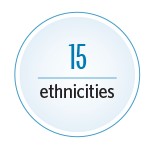
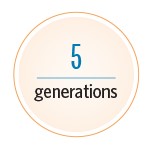
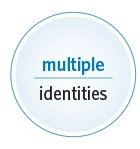
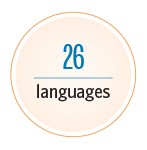
Overall, our employees represent a multitude of ethnicities and cultural backgrounds that help broaden the thinking and perspectives of our teams. We value the input of everyone, we embrace diverse perspectives that challenge our own, and we continually strive to foster a sense of belonging. That leads to high-performing teams that are continually focused on our mission. We recognize that a significant portion of our workforce will be retiring soon so we emphasize the importance of knowledge transfer and fair promotional opportunities. As a result, plans are in place to reassess our recruitment process to:
- Prepare tomorrow's workforce to fill impending vacancies through training, development, and mentoring programs as well as with ongoing recruitment efforts
- Provide fair and equitable opportunities for all and help move our team members into leadership positions
Evolving Data Collection Process
CalPERS relies on team member demographic data collected by the State Controller’s Office to inform the organization of its workforce gender and ethnicity profile. In 2020, we took a new approach by collecting voluntary data on race, ethnicity, sexual orientation, and gender identity through our fourth annual Employee Engagement Survey. Overall participation in the survey averaged around 80% while the voluntary participation in the new SOGI questions was about 74%.
2020 Employee Engagement Survey Demographics
Enterprise Ethnicity Demographics73% of total respondents
| Race | % of Total | ||
|---|---|---|---|
| Chinese * | 6.0% | ||
| Filipino * | 3.0% | ||
| Indian * | 4.0% | ||
| Japanese * | 1.0% | ||
| Korean * | 0.3% | ||
| Laotian * | 0.3% | ||
| Other Asian or Multiple * | 2.0% | ||
| Vietnamese * | 3.0% | ||
| Black or African American | 4.0% | ||
| Hispanic or Latino | 11.0% | ||
| Native American or Alaska Native | 0.2% | ||
| Pacific Islander, Other, or Multiple | 1.0% | ||
| White | 32.0% | ||
| Other or Multiple Race | 6.0% | ||
| Unknown ** | 27.0% | ||
* New reporting categories
**Unknown category represents employees who chose not to respond
72% of total respondents
| Sexual Orientation | % of Total | ||
|---|---|---|---|
| Bisexual | 1.0% | ||
| Gay | 1.0% | ||
| Queer | 0.4% | ||
| Straight/Heterosexual | 69.0% | ||
| Unknown * | 28.0% | ||
* Unknown category represents employees who chose not to respond
Gender Identity79% of total respondents
| Gender/Gender Identity | % of Total | ||
|---|---|---|---|
| Female | 46% | ||
| Male | 33% | ||
| Unknown | 21% | ||
State Controller’s Office Employee Demographics
Historically, CalPERS has received standardized employee demographic data from the State Controller’s Office. Here is the 2019-20 data shown with previous-years comparisons to illustrate changes and trends over the last four years:
Ethnic Diversity at CalPERS Over the Last Four Years| Ethnicity | 2016-17 | 2017-18 | 2018-19 | 2019-20 | |
|---|---|---|---|---|---|
| White | 45.10% | 44.75% | 43.12% | 42.81% | |
| Asian | 27.30% | 22.38% | 22.88% | 23.31% | |
| Hispanic | 14.30% | 15.37% | 15.87% | 15.72% | |
| African-American | 9.00% | 9.09% | 8.60% | 8.38% | |
| Filipino * | — | 4.74% | 4.41% | 4.19% | |
| Pacific Islander | 0.90% | 0.97% | 0.98% | 1.07% | |
| Native American | 0.30% | 0.36% | 0.36% | 0.37% | |
| Other | 2.50% | 2.73% | 3.11% | .70% | |
| Unknown | 0.60% | 0.55% | 0.65% | 0.85% | |
| Two or more | — | 0.07% | 0.03% | 2.59% | |
Source: State Controller's Office
* Filipino was not reported as a separate category for 2016-17
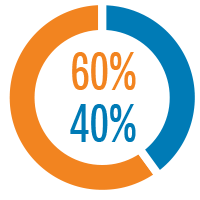
2016-17
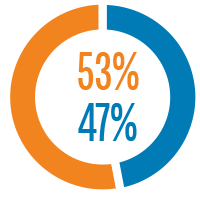
2017-18
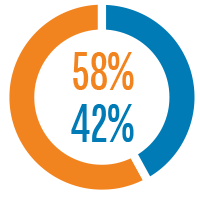
2018-19
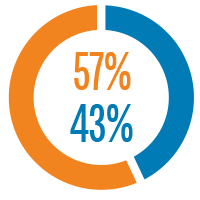
2019-20
Current Gender Diversity in Our Leadership
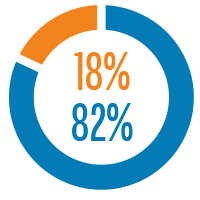
Executive Team
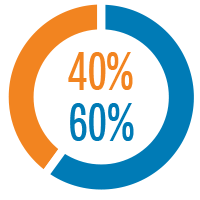
Senior Leaders
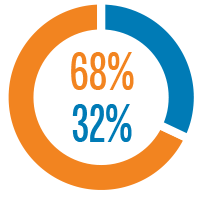
Team Leaders
Generational Diversity at CalPERS Over the Last Four Years
| Generation | 2016-17 | 2017-18 | 2018-19 | 2019-20 | |
|---|---|---|---|---|---|
| Traditionalists | 0.07% | 0.07% | 0.07% | 0.15% | |
| Baby Boomers | 23.20% | 21.48% | 19.08% | 17.09% | |
| Generation X | 46.10% | 46.19% | 46.63% | 47.59% | |
| Millennials | 30.63% | 32.26% | 34.22% | 34.69% | |
| Generation Z | – | – | – | 0.48% | |
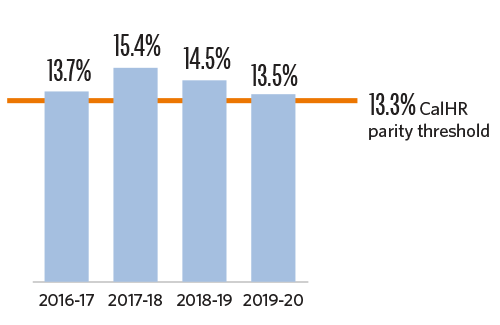
Education
CalPERS Diversity Outreach Program (CDOP)
CDOP leads the work of the diversity and inclusion business initiative across the enterprise, which was amplified by many disruptive crises. COVID-19 alone was enough to derail productivity and negatively impact mental health. In response, CDOP worked with teams across the enterprise to collaborate on supportive services, share direct employee feedback with leaders, and develop specific resources to address evolving circumstances.
2019-20 Fiscal Year Accomplishments
- 520+ team members in 13 different divisions participated in diversity and inclusion training
- 1,960 team members participated in enterprise-wide Unconscious Bias training, facilitated by Dr. Tyrone A. Holmes, Ed.D.
- 117 team leaders attended a Quarterly Leadership Development Workshop titled “The Diverse Mind: Mental Health in the Workplace”
- Published numerous intranet webpages with relevant reading material to raise awareness of the issues
- Provided useful tools to help team leaders facilitate productive conversations with their teams
- International Day of Persons with Disabilities – December 3, 2019
- Purpose: To demonstrate the new responsive myCalPERS website and show how accessibility boosts customer service
- Lunar New Year Celebration – January 15, 2020
- Purpose: To honor multicultural celebrations throughout Asia
- Event featured: Cultural exhibits representing China, Korea, Thailand, and Vietnam; activity booths featured papercutting, henna, and calligraphy
- Global Accessibility Awareness Day – May 21, 2020
- Purpose: To initiate discussions, thinking, and learning about digital accessibility
- Materials were provided to team members to help them better understand the need for accessible products and content, including virtual demonstrations on the importance of color, text size adjustment, and screen readers
- Festival of Lights – November 3-4, 2020
- Purpose: To honor multicultural celebrations of India
- Virtual event featured: A tour of India, a fashion show, and a series of cultural performances
The Human Resources Services Division training and leadership development teams quickly made the transition to online learning. Our leaders and emerging leaders were open to the experience of learning together in a virtual face-to-face atmosphere and reported an overwhelmingly positive experience.
2019-20 Fiscal Year Accomplishments
- Created a transition plan to incorporate virtual training delivery while continuing with current needs such as webinars and virtual instructor-led training
- Created 20 webinars and 12 virtual training classes with plans to continue converting in-classroom training classes to virtual delivery, based on organizational priority
- Delivered 13 leadership classes (non-required) that attracted 155 attendees
- Executed second half of 2020 Emerging Leader Program virtually
- Produced fourth quarterly leadership development workshop focused on mental health with updated information regarding COVID-19 pandemic, which drew 117 attendees
- Collaborated with CDOP and the D&I Council on Unconscious Bias seminars for leaders, followed by on-demand learning for all employees
Communication
Ongoing communication with team members and stakeholders is a top priority for CalPERS. The more we provide open, transparent information, the more we can build trust. Applying diversity and inclusion principles to our communication leads to authenticity and trustworthiness. It’s a cornerstone of building relationships with those we serve.
A significant new development to further embed and communicate diversity and inclusion issues was the establishment of the Diversity & Inclusion Council. Led by the Chief of Stakeholder Relations, who oversees the CalPERS Diversity Outreach Program, the Council is made up of key leaders and team members from multiple divisions across the organization. The Council’s sponsors include the Interim Chief Diversity & Inclusion Officer, the Chief Operating Officer, and the Deputy Executive Officer for Communications and Stakeholder Relations. The CalPERS Employee Resource Groups are also represented. The work of the Council is focused on exploring innovative ways to implement diversity, equity, and inclusion practices that will continually enhance the CalPERS culture, drive internal engagement with organizational priorities, and effectively interact with CalPERS members and those we conduct business with.
2019-20 Fiscal Year Accomplishments
- Launched weekly CEO webchats to facilitate ongoing engagement with CalPERS team members about the pandemic and organizational priorities
- Implemented digital D&I Newsletters on a variety of topics to help cultivate a high-performing, risk-intelligent, and innovative workplace
- Provided guidance and shared best practices with other state agencies for diversity and inclusion program development including CalHR, CalTrans, California Community Colleges Chancellors Office, Department of Industrial Relations, and Department of Motor Vehicles
- Helped develop the Statewide Committee on Diversity, Equity, and Inclusion
Our commitment to the people who work here is strengthened by our volunteer Employee Resource Groups (ERGs). They meet monthly in a safe, open forum to discuss diversity and inclusion issues and listen to employees’ emerging needs. Through grassroots action, the ERGs put diversity and inclusion front and center through events, educational programs, and development of online resources. Membership grew significantly by nearly 200%. This proved to be an especially valuable resource for employees as the nation witnessed waves of civil unrest, comprising protests and riots.
A few of this year’s highlights include:- Increased senior leadership engagement through the Diversity Advisory Council (DAC)
- Topics addressed in 2020 include:
- Unconscious Bias
- Conversations about racism/anti-racism
- Americans with Disabilities Act 30th Anniversary
- Accessibility for all ability levels
- Received 2020 “DAC of the Year” Award
The sudden shift to a remote work environment presented a new set of challenges as well as opportunities to further our goals for digital accessibility.
2019-20 Fiscal Year Accomplishments
- Provided 66 hours of education to information technology team on digital accessibility and development, mobile testing, and inclusive design
- Created a customized CommonLook Basic training document to support more than 150 subject matter experts for division accessibility
- Continued partnership with the Human Resources Services Division to develop customized accessibility trainings on Microsoft Word and Adobe Acrobat for the enterprise
- Redesigned the remote access environment to support connectivity including the following actions:
- Approved and fulfilled: 2,700 remote access requests to support work-from-home protocols (an increase of 1,561 over the previous fiscal year); Total RSA token users prior to COVID-19: 1,139; Total requests for RSA and Azure tokens: 1,620
- Created in-depth tutorial videos highlighting collaboration and facilitation features within Microsoft Teams and WebEx to support work-from-home business needs
- Upgraded network speed software that improved speeds up to 10 times
- Deployed over 750 devices and procured over 1,000 monitors, 1,300 PCs, 500 laptops, 500 webcams, and 100 smartphones
The CalPERS Diversity Outreach Program produced a number of newsletters to provide team members with relevant information in response to the issues including:
- How to Have Conversations on Racial Inequality in The Workplace
- COVID-19 and Your Mental Health
- The Importance of Human Connection
- Hard of Hearing and Working From Home
- COVID-19 Impacts on Persons With Disabilities
- Virtual Workplace Accountability
- COVID-19 Volunteer Opportunities
- Parenting In A Pandemic
- Virtual Team Building
Engagements
Investment Office Corporate Board Diversity & Inclusion Initiative
In August 2016, our Board’s Investment Committee adopted the Total Fund Governance & Sustainability Five-Year Strategic Plan, which identified improving corporate board diversity and inclusion as one of six strategic priorities of the Investment Office. The objective of this initiative is to improve corporate board diversity to enhance our total fund performance.
Board diversity is one of the three pillars of board quality as defined in our Governance & Sustainability Principles. Here are some of the key findings:
- Studies continue to indicate that greater board diversity can lead to lower volatility and better performance
- Using six diversity elements, including age, gender, and ethnicity, Bernile et al., found that diverse boards fostered more efficient risk-taking, invested more in research and development, and had greater innovation output per dollar invested
- A 2020 McKinsey & Company study found that companies whose boards are in the top quartile of gender diversity are 28% more likely than their peers to outperform financially
- In previous years, while the correlations were positive between board gender diversity and outperformance on earnings before interest and taxation (EBIT) margin, they were not statistically significant; now they are (Diversity Wins – How Inclusion Matters)
- Credit Suisse found excess returns of 3.5% per year between 2005-2015 for companies with at least one woman on the board
Our long-term goal is to ensure that all public companies we invest in have a level of board diversity that reflects each company’s business, customer base, workforce, and society in general. Through our corporate engagement process, we advocate for board diversity in terms of skill sets, gender, age, nationality, race, sexual orientation, gender identity, historically under-represented groups, experiences, thoughts, perspectives, and competencies.
2019-20 Fiscal Year Accomplishments
- Made progress in improving corporate board diversity including:
- Succeeded with 67% of companies engaged since July 2017 to add at least one diverse director to their boards (492 of 733 companies)
- Met our three-year Key Performance Indicator (KPI) from the Total Fund Governance & Sustainable Investments Strategic Plan adopted by the Investment Committee in August 2016 to have all S&P 500 companies have at least one female director on their boards (met the KPI in July 2019)
- Continued our partnership with CalSTRS and LACERA on the California Board Diversity Initiative to improve board diversity at California-headquartered companies
- Held directors at the companies we invest with accountable for lack of progress on improving corporate board diversity:
- Voted “against” 164 directors at companies where diversity engagements did not result in constructive outcomes. By comparison, we voted against 314 directors in 2019 and 468 directors in 2018
- Initiated CalPERS’ Diversity Director “Vote No” campaign targeted at 23 companies with multi-year unresponsiveness:
- Resulted in 14 companies either adding or committing to add elements of diversity to their boards
- Ran public “Vote No” campaigns with proxy solicitations at nine companies and voted against 29 directors—seven directors received more than 20% opposition, with one director failing to receive majority support
- Achieved market-wide improvements in corporate board diversity resulting in:
- 93% of Russell 3000 companies now have at least one female director compared to 78% in Q2 of 2017 (Source: Q2 2020 Equilar data)
- 23% of Russell 3000 board seats are now held by women compared to 16% in Q2 of 2017 (Source: Q2 2020 Equilar data)
- 59% of new independent directors at S&P 500 companies are women and minority men (Source: 2020 U.S. Spencer Stuart Board Index)
Disabled Veteran Business Enterprises (DVBE) & Small Business/Micro Business (SB/MB) Contracting
Since 2005, CalPERS has honored a commitment to award 3% of all eligible competitive contracts and procurements to DVBE contractors and establish an overall SB/MB contract participation goal of 25%, in keeping with state public contracting laws.
With the COVID-19 pandemic came the need to ensure a safe remote work environment for approximately 80% of our workforce by equipping team members with personal computers and laptop devices to work from home. The Information Technology Services Branch (ITSB) focused its efforts on DVBE providers when procuring software and hardware purchase orders. It also focused on the SB/DVBE Advocate’s ongoing efforts to ensure SB/DVBEs were considered for all eligible contracts and procurements. This resulted in CalPERS exceeding both DVBE and SB/MB goals, shown below.
2019-20 Fiscal Year Accomplishments
- Awarded 15.94% of all contracts to Disabled Veteran Business Enterprises – a 10.34% increase over Fiscal Year 2018-19, far exceeding the goal of 3%
- Awarded 25.94% of contracts to SB/MB organizations – a .94% increase over Fiscal Year 2018-19, just above the goal of 25%
Health Policy & Benefits
We launched a new business plan initiative for Fiscal Year 2020-21 to surface and root out health and health care inequities. We are committed to ensuring that care is individualized and equitable for all members, regardless of race, ethnicity, language, sexual orientation, and gender identity. This is important not only for people who currently need or receive treatment, but also for those who are working to stay healthy.
We incorporated sexual orientation and gender identity questions in the 2020 CalPERS Health Plan Member Survey, and are in the process of engaging with stakeholders to obtain data regarding race, ethnicity, language, sexual orientation, and gender identity. The data will be used to better understand the impacts and potential solutions to guide decisions that ensure health equity for all CalPERS health members.
Looking Ahead
If there’s one thing that 2020 proved, it’s the importance of a diverse and inclusive culture that motivates employees to meet challenges with resilience and positivity. In the coming year, CalPERS is particularly focused on closing the inequity gaps that may exist within our three lines of business—pensions, investments, and health care, the last of which is vital in the aftermath of a pandemic. That leads to the development of our Diversity, Equity, and Inclusion framework currently underway.
